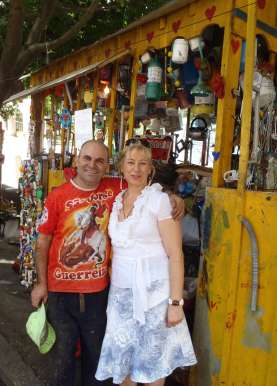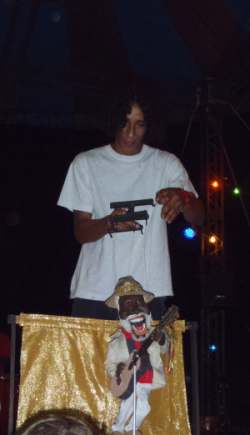
Centre For Local Research into Public Space (CELOS)
April 6, 2011
Artists in Santa Teresa

Kristen With Daniel Silva
Santa Teresa was once known for being a 'dodgy' neighborhood but over the past ten years this reputation has completely turned around largely because of all the visual artists that have made their home here. More than 80 artists show their work in Santa's annual studio tour in September 'Arte de Portas Abertas'. And at other times of the year art is everywhere to be seen in the streets.
The first artist that we meet is Daniel Silva a 'self made man' who was born and grew up in the favela Arara which is close to Mangueira, made famous for it's schools of Samba. Daniel, a fashion designer, is known for the exotic way in which he presents himself. He expresses himself through his dress and loves to wear long black coats even in 40 degree weather.
Proud of his community, he always has a positive take on life.
At the Bar do Minero we see puppets created by puppet master Marco Nogueira on permanent display and across the street is a painting by Arjan Martins, an artist from Santa. Arjan had a show of his work in Senegal last year. He promises to invite us to his studio where we can take a look at more of his paintings and talk about life as an artist in Rio de Janeiro.

View from a window in Santa Teresa looking out over the city of Rio de Janeiro
April 11, 2011
The Battle for Public Space in Rio de Janeiro

Getulio Damado
Popular artist Getulio Damado has found himself on the front lines in the current battle over public space in Rio de Janeiro. Recently an order came from the city, part of the 'Choque de Ordem' (Blitz of Order) clean-up in preparation for the World Cup of Soccer and the Olympic Games. Getulio was to vacate the space he has occupied on the sidewalk for 25 years since he first created his replica of the Santa Teresa tram. From here on the street, where Almirante Alexandrino meets with Leo Poldo Froes, 15, he has been creating art from 'junk' and cast-offs that show his 'love for children and his desire to make things for them'. His little cart has become a destination point for visitors to Santa and his work has been shown as far away as Germany and Holland.

Getulio Damado
Getulio jokes about his collecting abilities. He has been married six times and maintains regular communication with all of his ex-wives (except one)! As we talk together local actor Julio Adriano stops by with a small bag of plastic parts he has saved for Getulio. 'This man is an icon of this style of art and part of our cultural history. He gives more than he takes and has supported his children and grandchildren through his art works.'
The entire community has risen to defend Getulio Damado's right to be on this piece of sidewalk, a lawyer has offered to represent him and a petition grows in length. It appears that this outpouring of support is being heard. Getulio shows me an official letter from Rio Prefeitur (Rio City Hall) that he received only two days ago. Deputy Mayor Thiago Barcellos states that 'considering that artistic activity is of great cultural value...he has no objection to his permanent stay at this place.' Could this be the first victory in the fight against the sterilization of public space in Rio de Janeiro?

Fabio Negret
The Young Actor Fabio Negret
We continue on our way to visit Marcilio Barroco, the mask-maker with a deep understanding of the history of community art and collective art-making in Santa Teresa.
Passing through a park we encounter the young actor Fabio Negret studying the history of civilizations from a book. Self-educated, he is an example of dedication and commitment to become an actor. Fabio belongs to 'Cia dos Comuns' (Company of the Commons), a theatre group that develops works through a collaborative process.
A recent production was about the first Candace in the dynasty of female warrior queens in ancient Ethiopia. Candace ruled without a man, and parallels were drawn in the play with the situation of women in the favela who, for many reasons, find themselves alone and having to take care of things without support of men.
Fabio emphasized the importance of established artists in passing on knowledge to the youth - young artists struggling to make their way. This led us to reflect on how the movement away from the traditional apprenticeship model of the transfer of knowledge in the arts and towards a formal 'professional' institutional system of learning has closed one avenue of access for some young artists.
Upon meeting Marcilio Barroco, he brought our attention to the Casa da Flor. Created over many years by Gabriel Jouquim dos Santos (1892-1985), the son of slaves, it has become an icon in Brazil that resonates with these two prominent themes: the creation of art from cast-off and found materials, and the determination of the self-made artist.
A very fine web site about Casa da Flor is: http://www.casadaflor.org.br/english/hist.htm
More of our conversation with Marcilio Barroco later...
Memorial for Mestre Messias in Parque das Ruinas
On Sunday evening there was a memorial produced by the artists of Santa Teresa to honour the life of Mestre Messias who died this year one week before carnival. This man was born in Minas Gerais but lived for many years in Santa Teresa. A poet, musician, composer and painter he was known to all and was an inspiration to other local artists.
He was knowledgable in African music and composed Jongo music as well as Samba. And so, after the futbol match between Flamengo and Vasco came to it's conclusion with Flamengo scoring the winning goal in a penalty shot, the shouts could be heard throughout the city and people began to make their way up to the Parque das Ruinas.
Many musicians and Jongo dancers contributed to an evening of incredible song, percussion and dance that continued late into the night. Films of Maestre Messias were projected onto a wall to the side of the stage. A refreshing breeze blew across the top of the hill while the community joined the dance on stage. The children gathered in awe as puppet master Marco Nogueira performed with a puppet he had created of Maestre Messias singing one of his songs.
Here is a poem written by Henrique Pio in honor of Maestre Messias:
La se foi o poeta Messias.
Uma morte calculada
Nao morreu na vespera
Nem tão pouco no dia
Morreu uma semana antes
Para dar tempo aos amigos
Se recuperarem
E assim, sem dor,
Brincarem o carnival.



 Show search options
Show search options






 You are on the [Local Artists] page of folder [Kristen Fahrig In Rio De Janeiro]
You are on the [Local Artists] page of folder [Kristen Fahrig In Rio De Janeiro] For the cover page of this folder go to the
For the cover page of this folder go to the 

